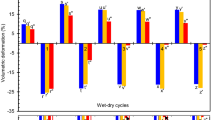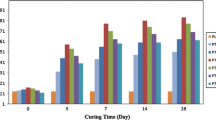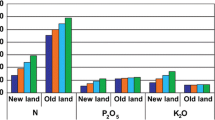Abstract
The type and amount of clay mineral plays an important role in the behaviour of fine-grained soils. Clay minerals are the primary source and moisture is often the external agent of swelling in soils. Also soils may exhibit increased/reduced swelling due to interaction with chemicals. Alkalis used in industrial operations are one such example. Concentrations of alkali and mineral type are the key factors in such interactions. The present paper reports the changes in the properties of an expansive Black Cotton soil containing a mixed layer mineral, rectorite upon interaction with high concentration caustic solutions. X-ray diffraction studies have shown that the rectorite present in the soil undergoes changes with increase in the concentration of alkali. Saponite gets transformed to nantronite. Small amount of kaolinitic mineral present in the soil also reacts with alkali producing some changes in its mineralogy. Many hydroxides are produced. Differential thermal analysis studies have been supportive of these changes. Consequent of these changes, the soil-specific surface increases, changes its Atterberg limits and free swell volume increases. The results have been supported by the characteristics and behaviour of samples contaminated in the field with alkali from an alumina extraction plant.








Similar content being viewed by others
References
Ass’ad A (1998) Differential upheaval of phosphoric acid storage tanks in Aqaba, Jordan. ASCE J Perform Constr Facil 12:71–76
ASTM D427 (1998) Test method for shrinkage factors of soils by the mercury method. American Society for Testing and Materials, West Conshohocken, PA
ASTM D422-63 (2002) Standard test method for particle-size analysis of soils. American Society for Testing and Materials, West Conshohocken, PA
ASTM D4318 (2000) Standard test methods for liquid limit, plastic limit, and plasticity index of soils. American Society for Testing and Materials, West Conshohocken, PA
ASTM D854 (2002) Standard test methods for specific gravity of soil solids by water pycnometer. American Society for Testing and Materials, West Conshohocken, PA
Bailey SW, Brindley GW, Kodama H, Martin RT (1982) Report of the clay minerals society nomenclature committee for 1980–1981. Clay Clay Miner 30:76–78
Bhattacharya T, Pal DK, Deshpande SB (1993) Genesis and transformation of minerals in the formation of red (Alfisols) and black (Inceptsols and Vertisols) soils on Deccan absalt in the Western Ghats, India. J Soil Sci 44:159–171
BS: 1377-1990 British Standard methods of test for soil for engineering purposes. Part 2. Determination of liquid limit, preferred method using the cone penetrometer
Casagrande A (1932) Research of Atterberg limits of soils. Public Roads 13(8):121–136
Gillot JE (1968) Clay in engineering geology. Elsevier, New York
Gregg SG, Sing KSW (1982) Adsorption, surface area and porosity. Academic Press, London
Harder H (1976) Nontronite synthesis at low temperatures. Chem Geol 18:169–180
IS 1498-2002 Indian Standard Classification and identification of soils for general engineering purposes. Bureau of Indian Standards, New Delhi, India
Jozefaciuk G (2002) Effect of acid and alkali treatments on surface-charge properties of selected minerals. Clay Clay Miner 50:647–656
Jozefaciuk G, Bowanko G (2002) Effect of acid and alkali treatments on surface areas and adsorption energies of selected minerals. Clay Clay Miner 50:771–783
Lowell S (1979) Introduction to powder surface area. Wiley, New York
Lukas RG, Gnaedonger RJ Jr (1972) Settlement due to chemical attack of soils. In: Proceedings of ASCE specialty conference on performance of earth and earth supported structures, vol 1. Purdue University, Lafayette, Lundiana, pp 1087–1104
Meyers KS, Speyer RF (2004) Thermal analysis of clays. In: Brown ME, Gallagher PK (eds) Handbook of thermal analysis and calorimetry, vol 2: applications to inorganic and miscellaneous materials. Elsevier B.V., Amsterdam, pp 261–303
Mitchell JK (1993) Fundamentals of soil behaviour. Wiley, New York
Mohnot SM, Bae JH (1985) A study of alkali–mineral reactions. Part II. International symposium on oil field and geothermal chemistry, Phoenix, AZ, SPE 13576
Olive WW, Chleborad AF, Frahme CW, Schlocker J, Schneider RR, Shuster RL (1989) Swelling clays map of the conterminous United States. US Geological Survey Publication, USGS, USA
Parthasarathy G, Choudary BM, Sreedhar B, Kunwar AC, Srinivasan R (2003) Ferrous saponite from the Deccan Trap, India, and its application in adsorption and reduction of hexavalent chromium. Am Miner 88:1983–1988
PCPDFWIN (1999) JCPDS-ICDD, USA
Poppe LJ, Paskevich VF, Hathaway JC, Blackwood DS (2003) A laboratory manual for X-ray powder diffraction. US Geological Survey Open-File Report 01-041. http://pubs.usgs.gov/of/of01-041/htmldocs/methods.html, Aug
Puri BR, Murari K (1963) Studies in surface area measurements of soils. 1. Comparison of different methods. Soil Sci 96:331–336
Qafoku NP, Ainsworth CC, Szecsody JE, Qafoku OS (2004) Transport-controlled kinetics of dissolution and precipitation in the sediments under alkaline and saline conditions. Geochim Cosmochim Acta 68(14):2981–2995
Rao SM, Rao KSS (1994) Ground heaving from caustic soda solution spillage—a case study. Soil Found (Japanese Society of Soil Mechanics and Foundation Engineering) 34(2):13–18
Rao SM, Reddy PMR (1997) Laboratory studies on the volume change characteristics of Kaolinite contaminated with sodium phosphate/sulphate. Geotechn Test J ASTM 20(3):362–367
Rao SM, Sridharan A (1985) Mechanism controlling the volume change behaviour of kaolinite. Clay Clay Miner 33(4):323–328
Sivapullaiah PV, Manju (2005) Kaolinite–alkali interactions and effects on basic properties: geotechnical and geological engineering. Kluwer, Netherlands
Sridharan A, Rao SM, Gajarajan VS (1987) Influence of fluoride on the compressibility of montmorillonites. Geotechnique 37(2):197–206
Sudo T, Shimoda S (1970) Interstratified phyllosilicates. In: Mackenzie RC (ed) Differential thermal analysis, vol 1. Academic Press, London, pp 539–551
Terzaghi K, Peck RB, Mesri G (1996) Soil mechanics in engineering practice. Wiley, New York
Author information
Authors and Affiliations
Corresponding author
Rights and permissions
About this article
Cite this article
Sivapullaiah, P.V., Sankara, G. & Allam, M.M. Mineralogical changes and geotechnical properties of an expansive soil interacted with caustic solution. Environ Earth Sci 60, 1189–1199 (2010). https://doi.org/10.1007/s12665-009-0260-9
Received:
Accepted:
Published:
Issue Date:
DOI: https://doi.org/10.1007/s12665-009-0260-9




